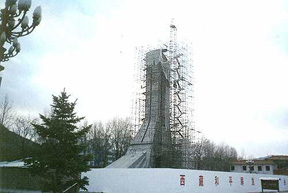
A new monument to commemorate the 50th anniversary last year of the "peaceful liberation" of Tibet has been erected in the Potala Palace Square in Tibet's capital, Lhasa.
Photographs of the 37-metre high structure, which cost 14.6 million yuan ($1.7 million) and is intended to be "an abstract representation of Mount Everest", can be viewed on TIN's website.
A Tibetan in his early twenties who has recently arrived in exile from Lhasa told TIN: "The authorities clearly want to show the contradiction between the two societies, the old and the new - the Potala representing the Tibetan government of the old society and the monument as a symbol of the new society [under Chinese rule]. The authorities aim to draw attention to progress that has been made in Tibet over the past 50 years, but it is a superficial progress that is not reflected in the lives of Tibetan people."
Vice-President Hu Jintao laid the foundation stone for the monument, which is also intended to commemorate "national unity", during his visit to Tibet last July. During the ceremony, Wang Zhaoguo, head of the United Front Work Department of the Chinese Communist Party Central Committee, drew attention to the political significance of the monument. He said: "At this moment in time, we join with all nationalities in Tibet and deeply cherish the strategic policies of the old generation of proletarian revolutionaries such as Mao Zedong, Zhou Enlai, Liu Shaoqi, Zhu De and Deng Xiaoping; in cherishing the memory of the revolutionary martyrs who spilled their blood, gave their youth and even their precious lives for the peaceful liberation of Tibet; and to all the officers and men of the People's Liberation Army and the working personnel who entered Tibet.!" (People's Daily, 18 July 2001). No comprehensive figures are available of the number of Tibetans killed by Chinese troops during the invasion of 1949-50, after Mao Zedong declared the Party's intent to "liberate" Tibet. One Chinese account states that more than 5,700 Tibetans were killed in the strategically important battle for Chamdo (Ch: Changdu) in eastern Tibetan in October 1950 [account by Zhang Guohua, reported by South China Morning Post in 1962 and quoted in "Dragon in the Land of Snows: A History of Modern Tibet since 1947" by Tsering Shakya, Pimlico, 1999]
A Tibetan exile from Lhasa told TIN: "The monument represents the 'peaceful liberation', which for Tibetans was a bad time, so how can Tibetans appreciate a statue like that?" Another Tibetan said: "The Potala was an important place in Lhasa for Tibetans, before it used to be very beautiful area, with trees and flowers, but now it has been made into a flat square, where there is a Chinese flag. It makes us angry to see this new monument, but we have no means to do anything about it."
A set of photographs of the monument in the Potala Square can be viewed at TIN's website at: http://www.tibetinfo.net/reports/culture/monument1.htm








